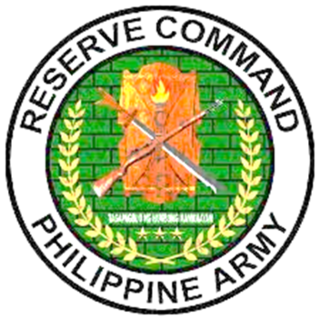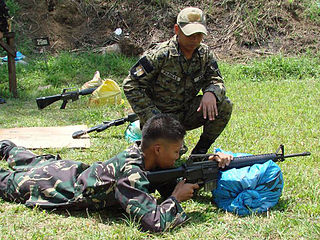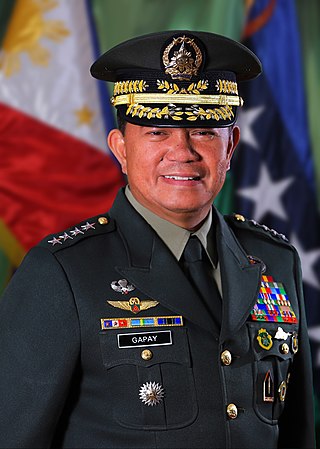
The Armed Forces of the Philippines (AFP) are the military forces of the Philippines. It consists of three main service branches; the Army, the Air Force, and the Navy. The President of the Philippines is the Commander-in-Chief of the AFP and forms military policy with the Department of National Defense, an executive department acting as the principal organ by which military policy is carried out, while the Chief of Staff of the Armed Forces of the Philippines serves as the overall commander and the highest-ranking officer in the AFP.
An officer candidate school (OCS) is a military school which trains civilians and enlisted personnel in order for them to gain a commission as officers in the armed forces of a country. How OCS is run differs between countries and services. Typically, officer candidates have already attained post-secondary education, and sometimes a bachelor's degree, and undergo a short duration of training which focuses primarily on military skills and leadership. This is in contrast with a military academy which includes academic instruction leading to a bachelor's degree.
A cadet is a student or trainee within various organisations, primarily in military contexts where individuals undergo training to become commissioned officers. However, several civilian organisations, including civil aviation groups, maritime organisations, and police services, also designate their trainees as cadets.
Officer candidate or officer aspirant (OA) is a rank in some militaries of the world that is an appointed position while a person is in training to become an officer. More often than not, an officer candidate was a civilian who applied to join the military directly as an officer. Officer candidates are, therefore, not considered of the same status as enlisted personnel.

The United States Army's Officer Candidate School (OCS) is an officer training program that trains, assesses, and evaluates potential commissioned officers of the U.S. Army, U.S. Army Reserve, and Army National Guard. Officer Candidates are former enlisted members, Warrant Officers, inter-service transfers, or civilian college graduates who have enlisted as an "09S" to attend OCS after they have completed Basic Combat Training (BCT).

The Philippine Navy (PN) is the naval warfare service branch of the Armed Forces of the Philippines. It has an estimated strength of 24,500 active service personnel, including the 10,300-strong Philippine Marine Corps. It operates 90 combat vessels, 16 auxiliary vessels, 25 manned aircraft and 8 unmanned aerial vehicles. Tracing its roots from the Philippine Revolutionary Navy on May 20, 1898, while its modern foundations were created during the creation of the Offshore Patrol on February 9, 1939, the PN is currently responsible for naval warfare operations and maritime patrol missions within the Philippine Waters, as well as ensuring the protection of the Philippine's maritime interests, including the South China Sea and Benham Rise.

The United States Navy's Officer Candidate School provides initial training for officers of the line and select operational staff corps communities in the United States Navy. Along with United States Naval Academy (USNA) and Naval Reserve Officer Training Corps (NROTC), OCS is one of three principal sources of newly commissioned naval officers.

Philippine Merchant Marine Academy is a maritime higher education institution operated by the Philippine government in San Narciso, Zambales. Students are called midshipmen but are often also referred to as cadets. Upon graduation, students are commissioned as ensigns in the Philippine Navy Reserve and have the option to join the merchant marine, the Philippine Navy, or the Philippine Coast Guard.

Hermogenes Cendaña Esperon Jr. is a retired Philippine Army general who served as the National Security Adviser in the Cabinet of President Rodrigo Duterte from 2016 to 2022. He was the Chief of Staff of the Armed Forces of the Philippines from 2006 to 2008 and Commanding General of the Philippine Army from 2005 to 2006 under President Gloria Macapagal Arroyo. After his retirement from the military, he served in Arroyo's administration as the Presidential Adviser on the Peace Process and later as the head of the Presidential Management Staff.

The Reserve Command is a major support command of the Philippine Army. It was created for the sole purpose of reserve force management, organization and Government Arsenal procurement.

Alexander Badong Yano is a retired Philippine Army general who served as the 38th Chief of Staff of the Armed Forces of the Philippines, the highest position in the AFP hierarchy. His Vice Chief of Staff was Lt. Gen. Cardozo M. Luna and his Deputy Chief of Staff was Lt. Gen. Rodrigo F. Maclang. Alexander Yano also served as the commander of the Philippine Army and Southern Luzon Command. He is also the first general born from Mindanao

The Armed Forces of the Philippines Reserve Command, known officially as the AFP RESCOM or RESCOM, is one of the Armed Forces of the Philippines' Major Support Commands created for the sole purpose of Reserve Force management, procurement, and organization.

Ricardo A. David, Jr is a former Chief of staff of the Philippine Armed Forces. He was the Armed Forces Northern Luzon Command chief. On June 30, 2010, President Benigno Aquino III picked David as his AFP chief. On July 2, 2010, Ricardo David assumes the command of the Armed Forces of the Philippines from Lt Gen. Nestor Z Ochoa. He currently serves as the Undersecretary for Defense Policy of the Department of National Defense.

Delfin C. Castro was a major general of the Armed Forces of the Philippines. He was the commander of the AFP Southern Command (SOUTHCOM), from 1981 to 1986. Notable incidents during his tenure include the Pata Island massacre, the assassination of Zamboanga City Mayor Cesar Climaco, the rescue of kidnapped Bishop Federico O. Escaler from Muslim rebels and the strafing of the Japanese vessel Hegg by Philippine Air Force fighters off Mindanao.

An officer is a person who holds a position of authority as a member of an armed force or uniformed service.

Reserve Officers' Training Corps (ROTC) in the Philippines is one of three components of the National Service Training Program, the civic education and defense preparedness program for Filipino college students. ROTC aims to provide military education and training for students to mobilize them for national defense preparedness. Its specific objectives include preparation of college students for service in the Armed Forces of the Philippines in the event of an emergency and their training to become reservists and potential commissioned officers of the AFP.
Rozzano Dosado Briguez is a Filipino general who formerly served as the Commanding General of the Philippine Air Force. He is a graduate of the Philippine Military Academy "Sinagtala" Class of 1986, and graduated as Top 2 of his class. He was also a commander of the AFP Western Command, and formulated the new command framework: "Padayon PAF: Perform, Reform, Transform", a framework of his leadership philosophy in the Philippine Air Force.

Gilbert Italia Gapay is a retired Philippine Army general who served as the 54th Chief of Staff of the Armed Forces of the Philippines. Prior to his appointment, he served as the 61st Chief of the Army and the commander of the Armor "Pambato" Division.
In the Philippines, Cadet is a rank held by candidate officer during the training to become commissioned officers in their preferred branch of military service.

The Philippine Coast Guard Officers' Basic Education and Training Center (PCGOBETC) serves as the officer candidate school of Philippine Coast Guard officer aspirants. Cadets who are already baccalaureate degree holders taking the Coast Guard Officers’ Course (CGOC) became Probationary Ensigns (PENS) and after graduation are commissioned as regular officers in the organization.




















